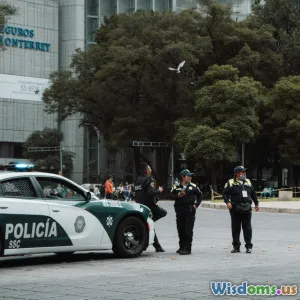
How Police Decode Clues Left at Abduction Scenes
10 min read Explore how police meticulously uncover and interpret clues at abduction scenes to solve cases and save lives. (0 Reviews)
How Police Decode Clues Left at Abduction Scenes
Introduction
Every year, thousands of abductions send shockwaves through communities worldwide. In those harrowing moments following an abduction, police face the daunting task of piecing together clues from often chaotic and traumatic scenes. The way law enforcement deciphers these clues is a blend of science, intuition, and painstaking detail-oriented work. Understanding how police decode these clues offers insight into the mechanics behind solving such high-stakes cases. It highlights the intersection of forensic technology, investigative psychology, and ground-level detective work that converges to uncover truth and bring perpetrators to justice.
In this article, we will explore the step-by-step methods and tools police use to investigate abduction scenes. Drawing from real-world cases and expert commentary, we’ll examine how seemingly minor details become powerful evidence. Whether it’s a drop of blood, a discarded fabric, or behavioral patterns deduced from the environment, clues fuel the investigation. The stakes could not be higher — decoding these clues quickly can make the difference between rescue and tragedy.
Understanding the Crime Scene: Establishing Control and Preservation
Securing the Scene
The first vital step in an abduction investigation is securing the scene to preserve physical evidence. Police personnel must cordon off the area to prevent contamination, especially since abduction scenes are often outdoors or public places with potential witnesses or passersby who unintentionally destroy evidence.
For example, in the 2013 abduction case of Elizabeth Smart, early scene control allowed investigators to capture significant forensic clues that led to the rescue within nine months. This initial preservation is crucial because any loss or contamination jeopardizes the integrity of the evidence and delays the investigation.
Systematic Documentation
Officers meticulously photograph and video record the scene, documenting every object’s position and condition from multiple angles. This creates an archival record that can be reviewed repeatedly without being physically present.
Sketches and digital crime scene reconstructions are often created to help investigators visualize the layout. Modern technology like 3D laser scanning—used in cases like the Madeleine McCann disappearance—helps police analyze spatial relationships and large outdoor areas with unprecedented precision.
Identifying and Collecting Physical Evidence
Forensic Evidence Handling
Among the critical clues are physical items that can link suspects to victims or places to timelines. Police look for blood traces, hair strands, fibers, footprints, tire tread impressions, and fingerprints.
In the case of the kidnapping of Jayme Closs in 2018, investigators found fibers and tire tracks near the family home that provided crucial links to the suspect. Experts then used microscopic and DNA analysis to confirm their origin.
Trace DNA and Touch Evidence
The strides in DNA technology have transformed abduction investigations. Even minute traces—often overlooked in the past—can now link individuals to a scene. This is commonly known as trace or touch DNA.
For instance, a single skin cell left on a broken window latch or a strand of hair on clothing might hold genetic material. Police collect these samples using special swabs and follow strict protocols to prevent contamination.
Laboratories utilize increasingly refined methods, including MPS (Massively Parallel Sequencing), to analyze degraded or tiny DNA samples to identify victims or suspects.
Digital Evidence and Surveillance
The rise of digital surveillance cameras in public spaces or private homes has provided investigators with a new kind of clue. Video footage can capture the abduction act or the perpetrator’s escape route.
In one notable case, police pieced together footage from different cameras across neighborhoods to track the movement of abduction suspects over hours, creating a timeline that was instrumental for arrest.
Additionally, cell phone data and GPS tracking often help pinpoint where abducted victims or suspects have traveled.
Behavioral and Psychological Insights: Reading the Invisible Clues
Victimology – Understanding the Target
An essential but subtle part of decoding clues involves understanding the victim’s profile and circumstances, known as victimology.
Police analyze behavioral patterns, routines, social ties, and vulnerabilities. Knowing why a victim was targeted provides insight into the abductor’s motivations and methods.
For instance, abductors may look for victims who exhibit isolation, recent family crises, or specific routines that make them accessible. These factors guide investigators where and how to search.
Crime Scene Psychology
Beyond physical traces, the condition and arrangement of the scene can reveal the perpetrator’s psychological state.
Was the scene staged? Are there signs of struggle? Presence of certain symbolic items or markings can suggest the nature of the abduction—whether it’s motivated by revenge, ransom, or psychopathy.
Experts in criminal profiling analyze these subtle behavioral clues. The FBI’s Behavioral Analysis Unit frequently assists with this process, creating profiles that narrow prime suspects.
Case Studies: Real-World Examples of Decoding Clues
The Elizabeth Smart Abduction (2002)
Elizabeth Smart’s abduction and rescue exemplify detailed police work decoding clues. Early recognition of unusual tire tracks near her home led investigators to a suspect living nearby with distinctive tattoos matching witness descriptions. Forensic analysis of binding materials used in the abduction and interviews with the victim after rescue accelerated the case closure.
The Jayme Closs Case (2018)
In Wisconsin, Jayme Closs was abducted after her parents were murdered. Investigators collected tire tread impressions in snowy conditions and matched them to the suspect’s snowmobile tracks. The painstaking physical evidence gathering amid a rural landscape helped triangulate the area to search.
Modern Technologies Empowering Investigations
DNA Phenotyping
This technique reconstructs physical features such as eye, hair color, and ancestry from DNA samples. It provides police with composite images when no witness exists, a breakthrough in abduction scenarios.
Geographic Profiling
By analyzing locations of abductions and related events, police predict the suspect’s likely base or routine. This geospatial analysis turns a jumble of data points into focused search areas.
Artificial Intelligence
AI tools sift through enormous datasets (phone records, social media, surveillance) faster than humanly possible, revealing hidden connections among suspects, victims, and locations.
Challenges and Ethical Considerations
Decoding clues at abduction scenes involves balancing urgency with respect for due process and privacy. Forensic methods must uphold high standards to avoid wrongful convictions from contamination or misinterpretation of evidence.
Moreover, the emotional toll on victims and communities demands sensitive handling of information and support throughout investigations.
Conclusion
The art and science of decoding clues left at abduction scenes is a critical pillar of modern policing. Armed with forensic innovations, behavioral insights, and meticulous investigative protocols, police can transform fragmentary evidence into actionable intelligence. The stakes—saving lives and delivering justice—drive relentless pursuit by law enforcement professionals worldwide.
As technology advances, these methods become more sophisticated, offering hope even in seemingly hopeless situations. Public awareness and vigilance also play important roles in helping police detect early signs of abduction, fostering safer communities.
Understanding this intricate investigative process not only honors the dedication of those involved but empowers society with knowledge to recognize and support efforts that combat abductions.
References
- Federal Bureau of Investigation. (n.d.). Behavioral Analysis Unit. Retrieved from https://www.fbi.gov/services/cirg/behavioral-analysis-unit
- National Center for Missing & Exploited Children. (n.d.). Techniques in Child Abduction Investigations. Retrieved from https://www.missingkids.org
- Butler, J.M. (2012). Advanced Topics in Forensic DNA Typing: Interpretation. Academic Press.
Disclaimer: This article is intended for educational purposes and does not provide specific legal advice.
Rate the Post
User Reviews
Other posts in Forensic Science
Popular Posts


















